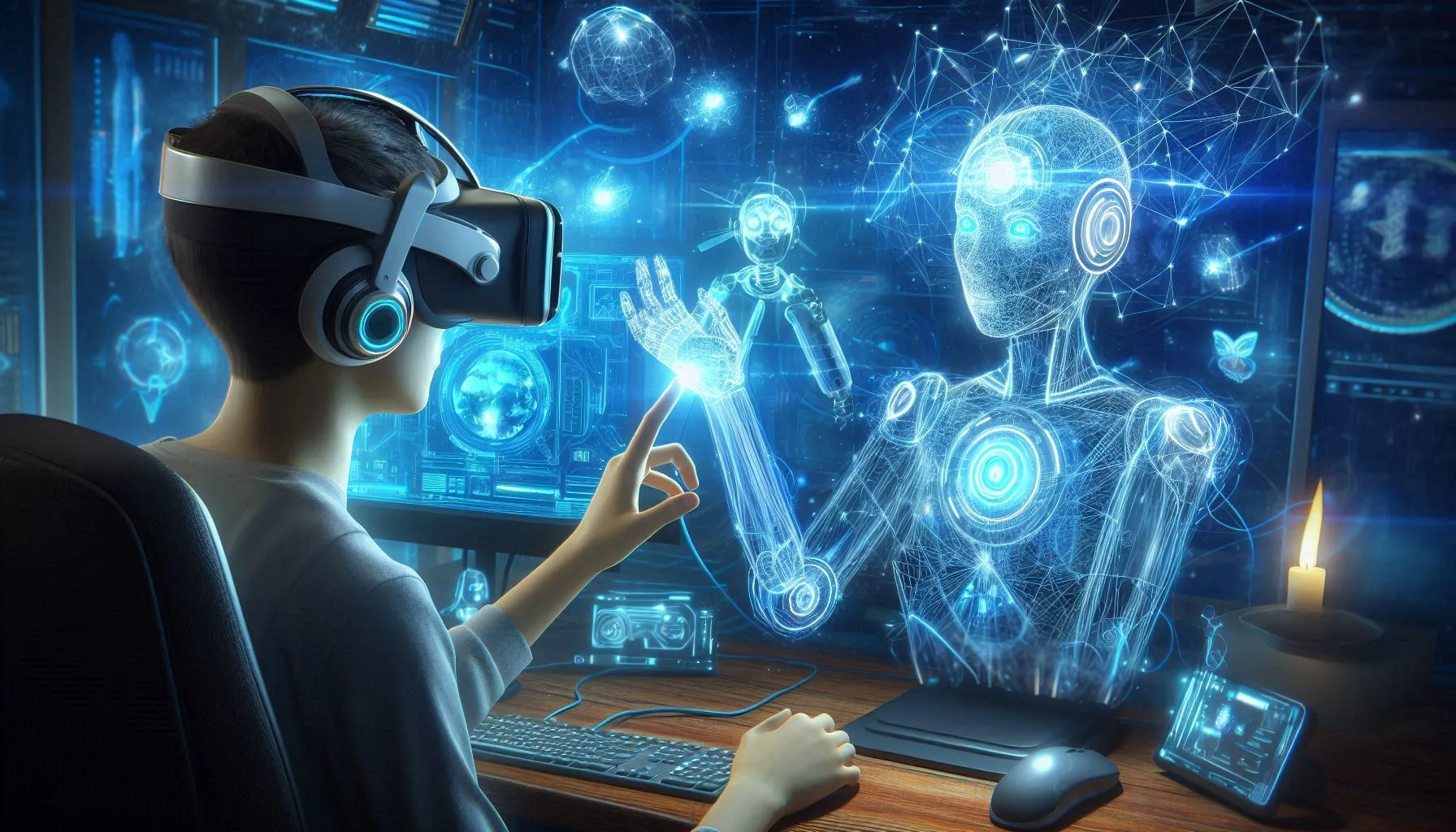Virtual Reality (VR) and Augmented Reality (AR) are transforming experiences across industries. When combined with Artificial Intelligence (AI), these immersive platforms like Meta Quest and Apple Vision go beyond visual effects to create interactive, responsive, and adaptive experiences. The future of VR and AR relies on AI’s potential to understand, predict, and personalize user experiences, pushing these technologies to unprecedented levels of engagement and interactivity.
1. AI’s Role in VR and AR: An Overview
- AI enhances VR and AR by enabling systems to learn from interactions, adapt to new inputs, and predict user needs. In VR and AR, AI algorithms interpret sensory data to adapt visuals, respond to voice commands, and engage users in real-time, crafting immersive worlds that feel alive.
- Integrating AI into VR and AR makes these platforms more adaptive and intuitive, opening possibilities in gaming, education, healthcare, and retail sectors. For example, in healthcare, an AI-powered AR application can help guide surgeons with real-time data, while in gaming, AI enhances non-player characters’ intelligence, making them more responsive and lifelike.
2. Applications of AI in VR/AR Technologies
Enhanced User Interfaces
AI facilitates intuitive user interfaces in VR and AR. Through voice recognition, gesture interpretation, and eye tracking, AI allows systems like Meta Quest and Apple Vision to adapt to users naturally. AI-driven interfaces create a seamless transition between real and virtual worlds, helping users focus on content and interactions without complex controls.
Object Recognition and Environment Mapping
Object recognition and environmental mapping are essential for AR experiences. Using AI, systems can identify and understand surroundings. Apple Vision, for example, could leverage AI to scan and understand a user’s environment and overlay digital information on objects in real-time. AI makes these overlays relevant by analyzing and contextualizing environmental data.
Personalized and Predictive Content
AI-driven personalization enhances the user experience by predicting preferences based on past behavior. VR and AR platforms can suggest content, adjust settings, or modify difficulty levels in real-time, catering to individual user profiles. This creates more engaging, enjoyable, and relevant experiences tailored to each user’s needs.
Immersive Interactions with AI Characters
AI brings virtual characters to life in both VR and AR environments. Using AI, characters can interpret player actions, remember past interactions, and evolve in response. In VR gaming, for example, AI characters on Meta Quest could adapt to a player’s strategy, adding layers of unpredictability and excitement.
3. The Future Capabilities of AI in VR and AR
Emotion Recognition and Adaptive Responses
Future AR and VR platforms could incorporate AI-based emotion recognition to assess a user’s emotional state through facial expressions, tone of voice, or body language. This allows the experience to adapt, creating more empathetic and responsive interactions. Imagine a VR game that becomes more challenging as it senses the user’s confidence level.
Real-Time Language Translation
AI-driven real-time translation could enable instant language adaptation in AR applications. Travelers could use Apple Vision’s AI to translate signs or menus, while VR platforms could facilitate multilingual communication in immersive virtual spaces. This technology could enhance accessibility and broaden VR/AR’s global reach.
Medical and Therapeutic Applications
In healthcare, AI-based VR and AR solutions are already assisting in surgery simulations, patient education, and rehabilitation. The future could see AI tracking patient progress, adjusting treatments based on data, and aiding mental health therapies by creating immersive scenarios tailored to an individual’s psychological needs.
Contextual AI for Education and Training
AI could tailor VR/AR learning experiences in real-time, adjusting difficulty, content depth, and feedback style. In VR training simulations, AI might adapt scenarios based on user performance, while in AR, students could interact with AI avatars who guide, assess, and encourage based on their needs.
Advanced AI-Driven Haptics
Advanced haptics create realistic sensations of touch within VR. AI can synchronize haptic feedback with visuals and sounds, adjusting responses based on user interactions. This development could allow users to feel textures and resistance, adding to the realism and immersion of VR and AR worlds.
4. AI-Driven Security and Privacy Enhancements in VR and AR
Privacy-Respecting Data Collection
AI plays a crucial role in collecting, processing, and securing data in AR/VR platforms while respecting user privacy. Through on-device processing, platforms like Meta Quest could ensure sensitive data, such as biometric identifiers, never leaves the user’s device, reducing the risk of unauthorized access.
Enhanced Authentication Methods
Future AR and VR systems may incorporate AI-powered biometric authentication, recognizing users by voice, facial expressions, or even gait. This adds an extra layer of security and customizes the VR/AR environment to fit individual user profiles.
5. Challenges and Ethical Considerations
Data Privacy and Consent
With AI-driven insights, VR/AR technologies gather extensive data. Ensuring data privacy and transparent user consent will be essential. Companies must create safeguards, informing users about data collection practices and protecting sensitive information.
Preventing Bias in AI Models
AI models that power VR and AR need extensive training data, which may carry biases if not carefully curated. These biases can affect character interactions, content recommendations, and other AI-driven functionalities. Companies must address biases to ensure fair and inclusive experiences.
6. Future Potential and Innovations
Realistic AI NPCs and Virtual Companions
AI will make non-player characters (NPCs) in VR experiences more complex, lifelike, and unpredictable. In gaming, for instance, NPCs could have dynamic relationships with players based on repeated interactions. Beyond gaming, AI companions might serve as tutors, guides, or even wellness coaches, supporting users in various VR applications.
AI-Generated Virtual Environments
AI’s ability to generate content in real time allows VR environments to evolve based on user preferences. Imagine a VR workspace where AI creates customized layouts, lighting, and decor according to each session’s requirements. Similarly, AR could enable home designs where users visualize custom layouts that update instantly with AI assistance.
AI in Collaborative VR and AR Spaces
Collaborative virtual spaces powered by AI could enhance productivity and social interaction. AI can streamline coordination by translating languages, scheduling meetings, and tracking shared goals. This is particularly useful in hybrid work models, allowing teams to collaborate from anywhere with AR/VR tools that adapt to everyone’s language and role.
Conclusion
AI is the driving force that will enable VR and AR technologies to reach new heights. Platforms like Meta Quest and Apple Vision will rely on AI to make virtual environments more immersive, personalized, and responsive. From education and healthcare to gaming and workspaces, AI will create customized and interactive experiences that adapt to the user in real-time. While challenges in data privacy and ethical AI development remain, these issues are already receiving industry attention. In the years to come, the convergence of AI with VR and AR will shape new realities that blend seamlessly with our own, expanding the potential of immersive technology.




